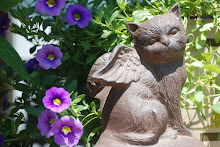eginning September 30th through October 27th we celebrate the Celtic Tree month of Ivy. Although Ivy is not what most consider a tree, it still holds its place among the others in Celtic Tree Lore. Its uses and importance are just as strong as that of the Oak or Hazel. In the coming weeks we will examine a few of these important traits.
Ivy is a wild evergreen climbing vine that attaches itself to other trees as well as stone walls and other surfaces. It climbs such surfaces by fibers that grow our from every part of the stem. These fibers resembles roots and have small disks at the end by which it attaches itself to the roughness of the tree or wall it is climbing. If by chance the ivy finds soil or a deep crack the fibers will then become roots. These roots act as a means to obtain nourishment for the stem as it climbs. When this is done to another tree, the ivy can actually injure the tree it is attached to by taking of the trees life resources to aid itself.
Ivy only produces flowers when the branches get above their support. The flowering branches are bushy and come out from the climbing stem with flowers at the end of each shoot. Usually an ivy will flower during Autumn if there is enough sunlight. They appear as small clusters of greenish white or yellow . They can continue to bloom until late December. There bloom is scentless yet still they are a good source of food for birds, and insects during the cooler months when there is usually no other food source.
The fruit or berry of the ivy do not ripen until the following spring . Although this is true they still are a good source of food through the winter for birds and other wildlife. . When the berry does finally ripen it is likened to the size of a pea and are black or deep purple in color. They are not pleasant to taste and have a slightly resinous smell.
Although the ornamental covering that Ivy lends to the objects it climbs, left untended, it can become an aggressive invader. It can not only harm the tree it is connected to but alto others. Growing untended in the woods its dense growth and abundant leaves form a thick canopy that can keep the sunlight from reaching other plants below.
In early times ivy leaves were often given to cattle for food yet it was not something that they enjoyed eating. Likewise deer and other wildlife will eat them during winter only when there is nothing else. The wood that comes from Ivy is very soft and was seldom used. The wood is very porous and it was thought that it had the property of separating wine from water by filtration. Yet this was soon realized that the wood absorbed its color and the wine lost some of its flavor so it did not catch on.









4 comments:
What a lovely post. I enjoyed it. I love ivy. My grandma used to have it. As a matter of fact, I have one at home that has to be trimmed all the time or it takes over the bedroom.
Mary
Great post! I have ivy growing in my garden but I've never had it indoors. My grandmother was insistent it was unlucky to bring ivy indoors so I never have!
I like buildings covered with ivy that is struggling to get to the roof...
What a gorgeous post and filled with wonderful lore. I love ivy. So happy the month of ivy begins on my birthday! :) Theresa
Post a Comment